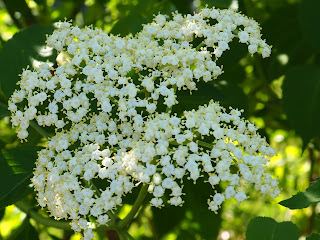June at the Preserve
Although the focus of the blog so far has been on herbaceous plants, native shrubs such as nannyberry (Viburnum lentago) also have complex ecosystem roles. Viburnum serves as a natural windbreak and its berry-like fruit provides an important food source to small mammals and birds in late fall. A wide range of pollinators are associated with viburnums, including beetles of the genus Cetonia. Scientists have observed branched hairs on the body of the Cetonia beetles similar to the pollen-collecting hairs found on bees. Viburnum is also a host plant for the spring azure butterfly, supporting the larval and adult stages of its life cycle.
Whorled loosestrife (Lysimachia quadrifolia) is another example of a native plant that sustains pollinators. Whorled loosestrife attracts the rare and highly specialized Macropis oil bee. The flowers provide pollen and floral oils, which the solitary bees use to construct nests and feed their larvae. In turn, the parasitic bee Epeoloides pilosula, endangered in Connecticut, depends on Macropis for its survival. E. pilosula deposits eggs within the Macropis nests. The emerging E. pilosula larvae then kill the Macropis populations to take advantage of their pollen stores. Although they are natural enemies, cleptoparasitic and oil bees both depend on loosestrife populations--directly and indirectly.
Although few know of oil bees, milkweed (Asclepias ssp.) has become ubiquitous among pollinator enthusiasts as the host plant for the monarch butterfly. In fact, the preserve was designated as a Monarch Waystation after the Land Trust planted swamp milkweed. Monarchs lay their eggs on the milkweed leaves, and when the caterpillars hatch they feed off the plant. Swamp milkweed also supports the nectaring activity of adult monarch butterflies; the unusual structure of milkweed flowers facilitates an elaborate process of pollination.
Each flower contains five nectar cups but instead of loose pollen, Asclepias pollen is clustered in sacs. Insects struggle to grasp the slippery surface of the petals when drinking nectar. Inadvertently, they may catch their legs in an upward opening slit, between the nectar cups and lined with bristles. As they try to escape, the insects pick up the pollen sacs. The process repeats as the insects deposit pollen inside the upward slit of the next flower.
 |
| Nannyberry (Viburnum lentago) draws a host of pollinators, including Cetonia beetles and the spring azure butterfly |
 |
| Sheep's sorrel (Rumex acetosella) is mainly wind pollinated |
 |
| Although regarded as a nuisance when found in crop plantings, Pennsylvania smartweed (Polygonum pensylvanica) produces seeds that attract a diversity of birds, including cardinals, horned lark, and sparrows. |
 |
| Chives are a well-known culinary herb, derived from wild chive (Allium schoenoprasum). The chives at the preserve could be a native population but are most likely garden escapes. |




Comments
Post a Comment